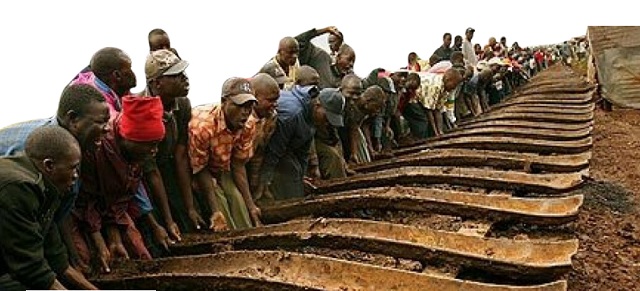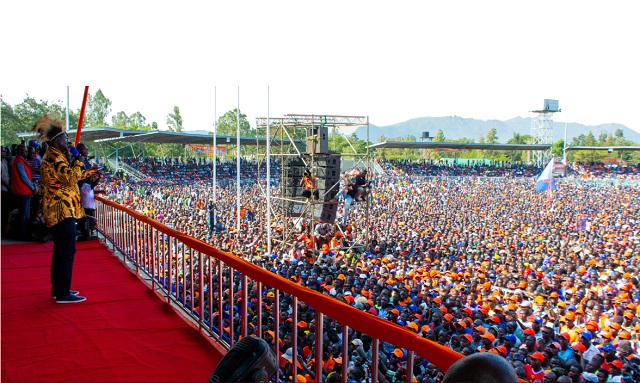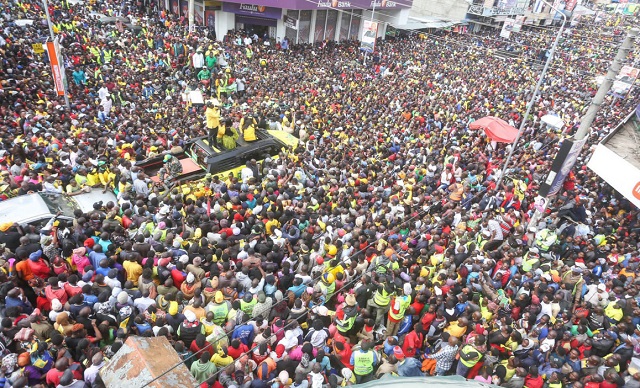
And why neighbours are watching every step
COVER STORY | THE INDEPENDENT | Kenyans are gearing up for an important general election on Aug. 09 that will end President Uhuru Kenyatta’s two terms in office.
It will be the country’s seventh general election since the resumption of multiparty electoral democracy 30 years ago. And it is the third under the progressive 2010 constitution that was part of reforms designed to address political animosities that ignited deadly election violence in 2007.
Voters are required to simultaneously vote for a president, senator, Member of Parliament, woman representative, county governor and county assembly member. With a population of 48 million, Kenya has 22 million registered voters. Nearly 40% of these are young voters.
Three presidential candidates, out of the four cleared to run, have captured the country’s imagination. Two are clearly ahead of the pack but there is no clear front-runner. That there is no clear favourite to win after months of campaigning is a credit to the competitiveness and relative freedom of the democratic space. But it does mean that this will be a tense few days until a decision is made on who will govern the East African economic powerhouse for the next five years.
The candidates
One of the two leading candidates is Raila Odinga, a former prime minister who leads the Azimio la Umoja (Declaration of Unity) coalition; one of the two main coalitions. The 77-year-old veteran Kenyan politician is contesting the election for the fifth time. He has come close to victory twice before. The 2007 poll result was hotly disputed, leading to widespread violence in which 1,100 people were killed.
Odinga is the son of post-independence Kenyan first vice-president, Jaramogi Oginga Odinga. Long seen as an anti-establishment candidate, Odinga has a common touch that resonates with Kenyans who have felt locked out of the power matrix controlled by two ethnic groups since independence in 1963 – the Kikuyu and Kalenjin. This time, though, he is the establishment candidate.
The other front-runner is William Ruto, 55. The sitting Deputy President is leader of the United Democratic Alliance, the largest party under the Kenya Kwanza (Kenya First) coalition. Against sustained pushback by the incumbent, Uhuru Kenyatta, Ruto is determined to succeed him.
Ruto has reinvented himself as the agent of class consciousness, an issue hitherto absent in Kenya’s political discourse and competition. By rebranding him as the antithesis of the status quo and personification of the hopes of the poor, his messaging has resonated with the marginalised.
Ruto frequently quotes the Bible. But this seemingly ecclesiastical bent masks a consummate political strategist.
While George Wajackoyah of the Roots Party has captured the public’s imagination, he and David Mwaura Waihiga of the Agano Party are fringe presidential aspirants. Fringe candidates play a significant role in testing democratic spaces for maturity. Their often atypical ideologies and beliefs give democracies a break from regular political themes.

Opinion polls
One week before voting, an opinion poll on Kenya’s presidential election showed Raila Odinga in front by six percentage points over William Ruto.
In the survey released on Aug.02 by the Ipsos group, 47% of respondents said they would vote for Raila Odinga in the upcoming election.
William Ruto was second at 41%, with George Wajackoya and David Mwaura a distant third and fourth respectively. Nine percent of voters were undecided.
Under Kenya’s election system, a candidate needs to win 50% of the vote plus one to be declared the winner and avoid a runoff.
“Should Raila convert half of the undecided voters he will win this election first round. If Dr. William Ruto converts 100 percent of the undeclared vote, he will force a re-run,” said Samuel Muthoka, the East and Horn of Africa director at Ipsos.
Another recent survey by Trends and Insights for Africa (TIFA) found that Odinga was the most preferred candidate at 46.7%, while Ruto polled at 44.4%.
The Ipsos survey, taken between July 23 and 30, shows Odinga’s sweet spot is his legacy as a democratic and experienced leader, while those who support Ruto believe he presents hope with a clearer plan for the country’s future.
Outgoing President Uhuru Kenyatta – whose final term in office ends after the polls – has been a key figure in East Africa. Over the last nine years, he has tried to create markets and address issues like peace, malaria and climate change.
Within the East African Community, he signaled the end of an era on 21 July when he handed over the bloc’s leadership to his Burundian counterpart, Evariste Ndayishimiye.
In an essay published in the online journal ‘The Conversation’ international relations scholar Nicodemus Minde explored five reasons why citizens of Uganda and other neighbouring states are following the change of guard in Nairobi very keenly.
Kenya’s president as ally
The first issue Nicodemus Minde points out is who President Yoweri Museveni and other East African leaders would want to be Kenya’s next president. This is mainly because today’s personal friendships can be used to advance or safeguard bilateral interests tomorrow.
On July 06, 2021, Museveni hosted Ruto as the chief guest when laying the foundation of a new vaccine facility, DEI Biopharma, slated to be the largest Pharmaceutical and Biopharmaceutical Products Company in the country.The event took place in Matuga town in Wakiso District in central Uganda. Museveni’s action was interpreted by some as an endorsement for Ruto.
Museveni is said to have a lukewarm relationship with the front runner; Odinga. It is said it stretches from 2008 when Odinga’s supporters uprooted the Kenya-Uganda railway line during the post-2007 election violence, disrupting exports to Uganda.
The youths said they were cutting off supplies to Uganda because Museveni had been the first to recognise President Mwai Kibaki’s election to a second term of office. In an apparent attempt to heal old wounds and appear even-handed, Museveni hosted Odinga in May this year. The two later said they discussed ways of strengthening relations between Kenya and Uganda.
Odinga had flown to Uganda from South Sudan, where, as the African Union High Representative for Infrastructure Development, he had gone to commission a 3.6km bridge that will connect Juba to the rest of the East African region. He was received there by President Salva Kiir.
At the event, Odinga talked of his presidential bid, pledging to re-open the troubled border with South Sudan and prioritise construction of a Mombasa-Juba highway, if he won the 9 August elections. President Kenyatta had in May 2018 appointed Odinga as his special envoy to South Sudan in the effort to reconcile Kiir and his vice-president, Riek Machar.
In Tanzania, the late Magufuli was a key ally of Odinga’s, thanks to a friendship forged when both were ministers for Works in their countries. Magufuli’s support for Odinga against Kenyatta in the 2013 and 2017 polls led to a perfunctory relationship with Kenyatta and tense relations between the two countries.
Magufuli’s successor Samia Suluhu Hassan was quick to restore friendly terms. But Tanzania, just like Rwanda and Burundi, has not shown any signs of leaning towards one candidate. Many Tanzanians have however been excited by rank outsider George Wajackoyah’s eccentric promises.

Transit trade
The landlocked countries in the region rely heavily on Kenya’s seaport and transport corridor. The maritime port of Mombasa serves parts of Tanzania, Burundi, the Democratic Republic of Congo (DRC), Rwanda, South Sudan and Uganda. These countries often follow very keenly how elections unfold in Kenya.
Kenya’s bungled 2007/8 political transition came as a surprise to many regional traders whose transit goods were destroyed along the transport corridor. The Northern Corridor and the Lamu Port-South Sudan-Ethiopia-Transport Corridor that run through Kenya are designed as key commercial arteries for landlocked countries in the region.
Political and economic network
Over the years, Kenya has been Uganda’s biggest trading partner. Uganda accounted for 29.3% of Kenya’s exports to Africa in 2020.
Kenya has always projected itself as a regional economic hub and an international political player. It has the largest economy in East Africa; almost double that of Tanzania and nearly three times that of Uganda.
Kenya’s exports to the East African Community increased from Ksh140.4 billion (US$1.28 billion) in 2019 to Ksh158.3 billion (US$1.44 billion) in 2020.
Tanzania, which previously had lukewarm relations with Kenya, has benefited immensely from rapprochement between Presidents Suluhu and Kenyatta. Recent reports indicate that bilateral trade hit US$905.5 million in the first 11 months of 2021 as their trade relations improved. Kenya has also maintained close economic ties with Rwanda and South Sudan.
Participatory politics and term limits
Kenya’s democratic trajectory has always been viewed by East African neighbours as the bellwether for being fairly participatory. The annulment of President Kenyatta’s electoral victory on 1 September 2017 also offered crucial lessons to neighbours.
As court reversed Kenyatta’s win, John Magufuli (Tanzania’s president at the time) had banned all political party activities, ushering in an era of brutal dictatorship. In Rwanda, President Paul Kagame had just been declared winner with 98.8% of the votes.
In neighbouring Burundi, President Pierre Nkurunziza had controversially extended his stay in power through a “third term.”
In Uganda, President Yoweri Museveni was just clocking 31 years in office and showing no signs of letting go. The other East African Community member state, South Sudan, was still embroiled in a civil war.
Only Tanzania has enjoyed periodic transitions, albeit through the one-party dominant system.
Kenya has experienced many democratic transitions since the reintroduction of multiparty politics in 1992. Despite its ethnic cleavages, Kenyan elections have been competitive. In 2002, there was a transition from the independence party, the Kenya African National Union, to the opposition National Alliance Rainbow Coalition.
Since the 1990s, Kenya has been the only country in East Africa to transfer power smoothly from a ruling party to the opposition.
Regional integration
In February this year, presidential candidate William Ruto made a diplomatic gaffe when he said the DR Congo did not have a single cow. He was speaking about Kenya’s dairy and beef investments.
The storm that erupted showed how quickly regional relations could sour. The remark epitomized the low priority assigned to the East Africa policy agenda among Kenyan presidential candidates – Raila Odinga included.
The DR Congo became the seventh member of the East African Community in April this year. President Kenyatta has steered the regional agenda, including the admission of the DR Congo. In June he hosted the East African leaders to discuss the tensions between Rwanda and the DR Congo. He has also taken political leadership in stabilizing Somalia and South Sudan.
The neighbouring states may wish to have as Kenya’s next president a person who continues to seek solutions to the conflicts of the region.
****
This article benefited from the views of Nicodemus Minde, Adjunct Lecturer, United States International University – Africa, and XN Iraki, Associate Professor, Faculty of Business and Management Sciences, University of Nairobi
Source: The Conversation
 The Independent Uganda: You get the Truth we Pay the Price
The Independent Uganda: You get the Truth we Pay the Price



KENYA THE FINAL PUSH
Tomorrow Kenya goes to polls in a highly charged contest between deputy president William Ruto of Kenya Kwanza and Baba Amolo Raila Odinga of Azimio Kenya….. The stakes couldn’t be higher following the last three presidential elections including that of 2007 the left scores of Kenyans dead. Kenya is dubbed as the economic hub of East Africa and an oasis of peace in the troubled great lakes region….so, if it falls, everyone gets to hear the thud. Just like most African countries, Kenya is a country with a history of broken promises. At the time of independence, Kenya had to contend with the growing groups of aggressive chiefs who were determined to preserve their power they had acquired from colonial rule. The settlers were at the time eager to hold onto their own privileges- there were also demands from the remnants of the mau mau rebellion. So, from the start, the state of Kenya was founded on rather shaky-grounds of rent seeking…. where various interest groups attempted to influence politico-economic outcomes. Such edifice has been calibrated in each and every preceding government in Kenya. The centralist-corporatist colonial tradition has been reproduced as a means to control power. While this logic places incumbent leaders above the law, It is rather against this edifice that opposing political formations tend to rally their bases. This is what makes African politics a game of “man eats man.” Kenyan politics is one of competing legacies… During the Jomo Kenyatta era, intra-party politics culminated into ostracisation where Jaramongi Odinga and the radical KPU died and buried at the opening of Limuru KANU conference in March 1966. The original KANU coalition, included not only the Kiambu – Kikuyu elites and Luo labor leader on one side but also populist Odinga – Kaggia alliance…. the Luo-Kikuyu squatters. Following the assassination of Tom Mboya- (a Luo) by a Kikuyu, the Luo naturally supported Odinga…. From then on, Odinga took a linear path to radical politics and as much as Kenyatta seemed to tolerate pluralism with the KANU party, he secretly undermined radicalism and this is what spat off the rivalry between the Kikuyu and the Luo. Prior to the Limuru conference, president Kenyatta had selected Daniel Arap Moi to handpick delegates who would attend the conference-this was a preemptive move to kick out any real or imaginary threat before the conference started. At the death of Kenyatta, Moi started at his bookend. He was to follow into his footsteps… futua nyayo za Mzee(forgive my Swahili). Moi, a lanky and plain looking Kalenjin of ungainly physical structure, although, lousy on the outlook, seemed to be a calculative politician of immense survival instincts. He publicly referred to Kenya as a single party democracy and before his death, he’d revived KANU and ushered Kenya into a multiparty democracy although along the same ethnic lines of old. From 1992 to 2002, Moi ruled Kenya by a simple majority…he did this by gerrymandering and creating his own opponents. In 2002, under the National Rainbow 🌈 coalition, Mwai Kibaki became president after defeating Uhuru Kenyatta of KANU….he doubled the feat by narrowly defeating Orange Democratic Movement of Raila Odinga in 2007. But after enacting the National Accord and Reconciliation Act, Odinga was appointed as prime minister in the same government. In 2013, Uhuru Kenyatta and William Ruto became the first president and deputy president respectively under the new constitution. The bond between a Kikuyu (in Uhuru Kenyatta) and Kalenjin (in William Ruto) had been reborn as had been the case with Arap Moi succeeding Jomo Kenyatta. But yet again we see infighting within the same administration where Uhuru Kenyatta sidelines his deputy William Ruto as had been the case in 1966 when Jomo Kenyatta sidelined Odinga in preference to Moi. What is unique about this election is that among the top two contending presidential candidates, there’s no Kikuyu…. however, both William and Odinga run to the land of Mt Kenya for a running mate. What are the odds….. Will it be…fuata nyayo za Mzee…in case Raila Odinga wins or Reke Tumanwo…..a parting shot….in case William Ruto wins….. What remarkably separates these two candidates is that if Raila Odinga wins the political landscape of the whole East African region changes…however, a Ruto win means the stay of the status quo…. So, it’s in the best interest of the Ugandan opposition that Raila Odinga wins…..ears on the ground
Rajab Kakyama.